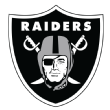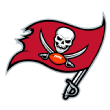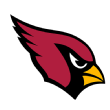In 2020, running back Josh Jacobs logged 273 carries and scored 12 touchdowns in Jon Gruden's run-heavy system. But with the addition of veteran Kenyan Drake, who also brings receiving upside to the Las Vegas backfield, there is now more competition for touches in the Raiders running back room.
Today, let's dive deeper into what to expect with the Raiders and other backfield battles that carry fantasy impact heading into NFL training camps, including the players I would target in my leagues this season.
 Las Vegas Raiders
Las Vegas Raiders
Josh Jacobs vs. Kenyan Drake
The arrival of Drake in Vegas is reflected by Jacobs' current ADP, which sits at RB18. There's competition for touches here, a year after Jacobs' yards per carry dropped from 4.8 in 2019 to 3.9 last season. However, the running back roles in Gruden's offense this year are key. Remember, Drake caught 85 of 123 targets in the 2017-18 seasons with Miami. He can threaten defenses as a pass-game back.
Yes, the newly signed free agent will get carries too, which will cut into Jacobs' overall volume and scoring totals. We know that. But for an offense that ranked eighth in rush rate last season (41.7%) and ninth in red zone drives (59), Jacobs is still an easy fit for a head coach that wants to run the ball -- which plays to the his downhill juice and short-area speed. Given that current ADP, I'm going to target Jacobs as a mid-to-low tier RB2, with Drake tagged as a flex option in deeper PPR leagues.
 San Francisco 49ers
San Francisco 49ers
Raheem Mostert vs. Trey Sermon
In a crowded running back room -- which also features Jeff Wilson, Wayne Gallman and sixth-round pick Elijah Mitchell -- Mostert should be viewed as a flex option with RB2 upside in Kyle Shanahan's offense. Think about this: since 2017, when Shanahan took over as the head coach in San Francisco, the 49ers have ranked fourth in fantasy running back points -- while also leading the NFL with an average of 2.82 yards per carry before first contact during that stretch, according to ESPN Fantasy researcher Kyle Soppe. Shanahan will use formation, alignment and pre-/post-snap movement to scheme up open daylight for runners in his system.
But let's focus on Sermon, too, who averaged 3.64 yards per carry after first contact last season at Ohio State. He has the traits of a professional runner -- contact balance, vision, pad level -- to ascend quickly on the 49ers' depth chart, in addition to his ability to produce as a receiver on swings and screens. Plus, with a current ADP of RB41, the rookie should be targeted in all scoring formats as a late-round sleeper in one of the NFL's best run offenses.
 Denver Broncos
Denver Broncos
Melvin Gordon III vs. Javonte Williams
Gordon still has that downhill ability in a Denver offense that ranked seventh in running back yards per carry before first contact last season (2.85). However, we are also talking about a veteran back who just passed the 1,500 career touch mark and saw his yards per carry after first contact drop to 1.78 over the past two seasons. And, based on the tape, I see a running back who isn't as explosive at this stage of his career. That's why I'm more focused on Williams in redraft leagues. The rookie averaged 4.61 yards after first contact in his final season at North Carolina. He's a downhill hammer, with the power to run through defenders and the open field juice/shake to create big plays.
Yes, Gordon has value as a mid-tier flex option, and he should see pretty consistent volume to start the season. But as this season progresses, I expect Williams -- with a current ADP of RB31 -- to cut into the veteran's touches. Additionally, with the Broncos owning the league's third-friendliest schedule during the ESPN fantasy playoffs, Williams could be in line to produce RB2 numbers when you need it the most. Target the rookie as a mid-round pick in your drafts.
 Tampa Bay Buccaneers
Tampa Bay Buccaneers
Leonard Fournette vs. Ronald Jones II
During last year's playoff run to a Super Bowl title, Fournette held a 64-to-35 postseason carry edge over Jones, including 300 yards rushing (compared to Jones' 139) and three rushing scores. However, if we look at the total season, it was Jones who averaged 34.7% more yards per carry than Fournette, despite running behind the same offensive line. Jones also had six games in 2020 with 15-plus carries, compared to only four from Fournette.
While you can point to Fournette's numbers on the playoff stage, plus his current ADP of RB28, to target a flex for your lineup, I still see more upside in non-PPR formats with Jones given his rushing traits. There's just more second-level juice on the tape, plus the ability to make defenders miss. Remember, Jones averaged 5.1 yards per carry in 2020, while Fournette checked in at 3.8, and has yet to average more than 4.35 in a single pro season. Plus, with Jones carrying an ADP of RB35, I think you can get solid value here as a flex in deeper leagues -- for an explosive Tampa offense that ranked fourth in red zone drives last season.
 Arizona Cardinals
Arizona Cardinals
Chase Edmonds vs. James Conner
Before the Cardinals signed Conner in free agency, Edmonds had the look of a possible feature back -- with three-down upside -- in Kliff Kingsbury's offense. However, with Conner now in the mix, and expected to see volume, Edmonds should be targeted as a high-end flex with PPR value. Last season, Edmonds caught 53 passes with four receiving touchdowns. And he will be schemed as a receiving threat in addition to the run-game totals he can produce.
Where does that leave Conner? With declining numbers in Pittsburgh, where his fantasy points per touch dropped from 1.05 in '18 to 0.98 in '19 and 0.81 in 2020, I'm not sold that the former Steeler can elevate to more than a lower-tier flex play. However, if he does see consistent, weekly volume in the same role that Drake held for the Cardinals last season, there is some scoring upside here for an Arizona offense that ranked fourth in red zone rush rate at 58.2%.
